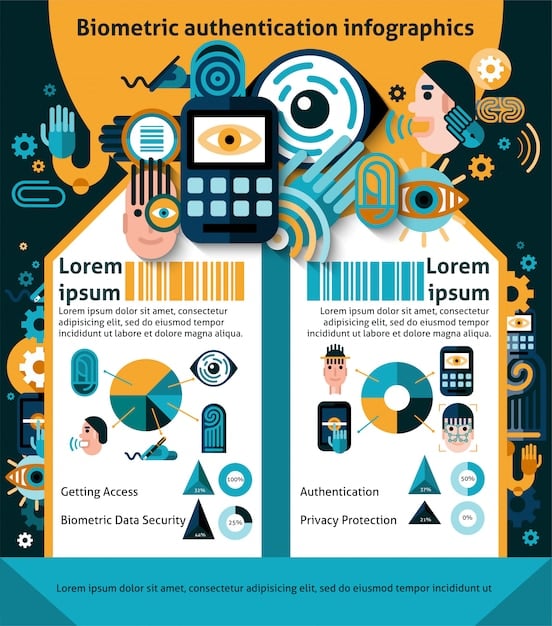Reduce Data Entry Errors with AI Automation Solutions for US Businesses

Reduce Data Entry Errors by 20% with These AI-Powered Automation Solutions for US Businesses explores how US companies can leverage AI to minimize errors and improve efficiency in data entry processes.
Are you tired of costly data entry errors impacting your business? Discover how reduce data entry errors by 20% with these AI-powered automation solutions for US businesses, streamlining operations and boosting accuracy.
Revolutionizing Data Entry: The AI Advantage
Data entry, while fundamental, is often a source of errors and inefficiencies in many US businesses. Traditional methods are prone to human error, leading to inaccuracies that can have significant financial and operational consequences. However, the rise of AI-powered automation solutions offers a transformative approach to this critical process.
By adopting these solutions, businesses can not only reduce errors but also free up valuable resources for more strategic and creative endeavors. The AI advantage lies in its ability to consistently and accurately process large volumes of data, learn from patterns, and adapt to changing requirements.
Understanding the Scope of Data Entry Errors
Data entry errors can take various forms, from simple typos to more complex misinterpretations of data. These errors can arise from fatigue, lack of training, or simply human oversight. Regardless of the cause, the consequences can be far-reaching.
- Financial Losses: Incorrect data can lead to inaccurate billing, invoicing errors, and ultimately, lost revenue.
- Operational Inefficiencies: Errors can disrupt workflows, requiring time-consuming manual corrections and rework.
- Customer Dissatisfaction: Inaccurate data can result in poor customer service, leading to complaints and lost business.
- Compliance Issues: In regulated industries, data entry errors can lead to compliance violations and potential penalties.

AI’s Role in Minimizing Human Error
AI-powered automation offers a powerful solution to minimize human error in data entry. These systems can be trained to recognize patterns, validate data inputs, and automatically correct errors in real-time. This proactive approach significantly reduces the likelihood of errors making their way into your database.
Furthermore, AI can handle repetitive tasks with consistent accuracy, freeing up human employees to focus on more complex and strategic projects. This leads to increased productivity, improved employee morale, and ultimately, a more efficient and profitable business.
In conclusion, the AI advantage in data entry is clear: reduced errors, increased efficiency, and improved overall business performance. By embracing these technologies, US businesses can transform a traditionally error-prone process into a reliable and valuable asset.
Selecting the Right AI Automation Solution
Implementing AI-powered automation for data entry isn’t a one-size-fits-all solution. US businesses need to carefully evaluate their specific needs and choose a solution that aligns with their unique requirements. Factors to consider include the type of data being processed, the volume of data, and the integration with existing systems.
A well-informed decision can ensure that the chosen AI automation solution effectively addresses the business’s pain points and delivers the desired results. It’s crucial to research different vendors, compare features, and consider the long-term scalability and maintenance of the solution.
Key Features to Look For
When evaluating AI automation solutions for data entry, certain key features can significantly impact their effectiveness. These features should be carefully considered to ensure that the solution meets the specific needs of the business.
- Optical Character Recognition (OCR): This technology enables the solution to automatically extract data from scanned documents and images.
- Natural Language Processing (NLP): NLP allows the solution to understand and process unstructured text data, such as emails and customer feedback.
- Machine Learning (ML): ML algorithms enable the solution to learn from data and improve its accuracy over time.
- Robotic Process Automation (RPA): RPA allows the solution to automate repetitive tasks, such as data entry and validation.
Integration with Existing Systems
Seamless integration with existing systems is crucial for the success of any AI automation solution. The solution should be able to connect with the business’s CRM, ERP, and other relevant software platforms without requiring extensive custom development.
A well-integrated solution ensures that data flows smoothly between systems, eliminating data silos and enabling a holistic view of the business. This can lead to improved decision-making, enhanced collaboration, and greater overall efficiency.
In conclusion, selecting the right AI automation solution for data entry requires a thorough understanding of the business’s specific needs, a careful evaluation of key features, and a focus on seamless integration with existing systems. By making a well-informed decision, US businesses can maximize the benefits of AI automation and achieve significant improvements in data accuracy and efficiency.
Implementing AI Automation: A Step-by-Step Guide
Implementing AI automation for data entry can seem daunting, but by following a structured approach, US businesses can ensure a smooth and successful transition. This involves careful planning, phased deployment, and ongoing monitoring and optimization.
A well-defined implementation plan can minimize disruption, maximize adoption, and ultimately deliver the desired results. It’s crucial to involve key stakeholders from different departments to ensure that the solution meets the diverse needs of the business.
Phase 1: Assessment and Planning
The first step in implementing AI automation is to conduct a thorough assessment of the current data entry processes. This involves identifying pain points, quantifying the impact of errors, and defining the desired outcomes of automation. Based on this assessment, a detailed implementation plan should be developed.
The plan should outline the scope of the project, the roles and responsibilities of team members, the timeline for deployment, and the metrics for measuring success. It should also address any potential challenges and mitigation strategies.
Phase 2: Pilot Deployment
Before rolling out AI automation across the entire organization, it’s recommended to conduct a pilot deployment in a specific department or business unit. This allows the team to test the solution in a real-world environment, identify any unforeseen issues, and refine the implementation plan.
The pilot deployment should be carefully monitored, and feedback from users should be actively solicited. This feedback can be used to fine-tune the solution and ensure that it meets the needs of the users.
Phase 3: Full-Scale Rollout
Once the pilot deployment has been successfully completed, the AI automation solution can be rolled out across the entire organization. This should be done in a phased approach, starting with the departments or business units that are most likely to benefit from automation.
Ongoing training and support should be provided to users to ensure that they are comfortable using the solution and can maximize its benefits. Regular monitoring and optimization should also be conducted to ensure that the solution continues to deliver the desired results.
In conclusion, implementing AI automation for data entry requires a structured approach, phased deployment, and ongoing monitoring and optimization. By following these steps, US businesses can ensure a smooth and successful transition and achieve significant improvements in data accuracy and efficiency.

The ROI of AI-Powered Data Entry Automation
Investing in AI-powered data entry automation can yield a significant return on investment (ROI) for US businesses. The benefits extend beyond simply reducing errors; they encompass increased efficiency, improved employee morale, and enhanced customer satisfaction.
A clear understanding of the potential ROI can help businesses justify the investment and prioritize the implementation of AI automation. It’s crucial to track key metrics before and after implementation to quantify the actual benefits achieved.
Quantifiable Benefits
Many of the benefits of AI-powered data entry automation can be easily quantified. These include:
- Reduced Error Rates: AI automation can significantly reduce data entry errors, leading to fewer financial losses and operational disruptions.
- Increased Efficiency: Automation can accelerate the data entry process, freeing up employees to focus on more strategic tasks.
- Lower Labor Costs: By automating data entry, businesses can reduce the need for manual labor, leading to cost savings.
- Improved Compliance: AI automation can help businesses comply with industry regulations by ensuring data accuracy and consistency.
Intangible Benefits
In addition to the quantifiable benefits, AI automation can also deliver intangible benefits that are harder to measure. These include:
Improved Employee Morale: By automating repetitive tasks, AI automation can free up employees to focus on more challenging and rewarding work, leading to increased job satisfaction.
- Enhanced Customer Satisfaction: Accurate data can lead to improved customer service and a better overall customer experience.
- Better Decision-Making: Reliable data provides a solid foundation for informed decision-making, leading to improved business outcomes.
In conclusion, the ROI of AI-powered data entry automation is significant and multifaceted. By carefully tracking key metrics and considering both quantifiable and intangible benefits, US businesses can justify the investment and maximize the return.
Overcoming Challenges in AI Automation Implementation
While AI automation offers numerous benefits, US businesses may encounter challenges during implementation. These challenges can range from technical issues to employee resistance. However, by anticipating these challenges and developing proactive mitigation strategies, businesses can increase the likelihood of a successful implementation.
Addressing these challenges head-on can minimize disruption, maximize adoption, and ultimately ensure that the AI automation solution delivers the desired results. It’s crucial to foster a culture of collaboration, communication, and continuous improvement throughout the implementation process.
Data Quality and Integration
One of the most common challenges is ensuring data quality and seamless integration with existing systems. AI automation relies on accurate and consistent data to function effectively. Poor data quality can lead to inaccurate results and undermine the benefits of automation. Similarly, integration challenges can create data silos and hinder the flow of information.
Employee Resistance
Another challenge is employee resistance to change. Some employees may fear that AI automation will replace their jobs, leading to anxiety and reluctance to adopt the new technology. Others may simply be resistant to change and prefer to stick with the familiar manual processes.
Effective communication, training, and support can help overcome employee resistance. Demonstrating the benefits of AI automation, such as reduced workload and increased job satisfaction, can also win over skeptical employees.
Security and Privacy
Security and privacy are also critical concerns when implementing AI automation. Businesses need to ensure that their data is protected from unauthorized access and that they comply with all relevant privacy regulations. This requires implementing robust security measures, such as encryption and access controls, and carefully vetting AI automation vendors.
In conclusion, overcoming challenges in AI automation implementation requires careful planning, proactive mitigation strategies, and a commitment to communication, training, and support. By addressing these challenges head-on, US businesses can maximize the benefits of AI automation and achieve significant improvements in data accuracy and efficiency.
The Future of Data Entry: AI and Beyond
The future of data entry is inextricably linked to AI and other emerging technologies. As AI continues to evolve, it will play an increasingly important role in automating data entry processes, improving accuracy, and freeing up human employees to focus on more strategic tasks. US businesses that embrace these technologies will be well-positioned to thrive in the increasingly competitive business landscape.
Beyond AI, other technologies, such as blockchain and the Internet of Things (IoT), are also poised to transform data entry. These technologies can enhance data security, improve data transparency, and enable new forms of data collection and analysis.
Evolving AI Capabilities
AI is rapidly evolving, and its capabilities in data entry are expanding accordingly. Future AI systems will be able to handle even more complex data types, such as video and audio, and will be able to learn and adapt more quickly. They will also be able to identify and correct errors with greater accuracy and efficiency.
Blockchain and Data Integrity
Blockchain technology can enhance data security and integrity by creating a tamper-proof record of all data entries. This can be particularly valuable in industries where data accuracy and provenance are critical, such as healthcare and finance.
The Internet of Things (IoT) and Automated Data Capture
The Internet of Things (IoT) can enable automated data capture from a wide range of sources, such as sensors, devices, and equipment. This can eliminate the need for manual data entry altogether, freeing up employees to focus on more strategic tasks.
In conclusion, the future of data entry is bright, with AI and other emerging technologies poised to transform the process and deliver significant benefits to US businesses. By staying abreast of these developments and embracing innovation, businesses can ensure that they are well-positioned to thrive in the years to come.
| Key Aspect | Brief Description |
|---|---|
| ✅ AI Automation | Leveraging AI tools to minimize errors in data entry processes. |
| 🚀 ROI Boost | Significant returns through efficiency, accuracy, and reduced labor costs. |
| 🛡️ Challenge Mitigations | Strategies to address data quality, employee resistance, and security concerns. |
| 🔮 Future Trends | Exploring AI advancements, blockchain, and IoT influence on data entry. |
Frequently Asked Questions
▼
AI systems use machine learning and pattern recognition to validate data inputs and automate corrections, significantly reducing human error and improving accuracy.
▼
Key features include OCR, NLP, machine learning, and RPA, which enable the solution to process various data types and automate repetitive tasks efficiently.
▼
Start with an assessment, proceed with a pilot deployment, and then gradually roll out the solution across your organization, providing training and support to users.
▼
The ROI includes reduced error rates, increased efficiency, lower labor costs, improved compliance, and enhanced employee and customer satisfaction levels.
▼
Challenges include ensuring data quality, integrating with existing systems, addressing employee resistance, and ensuring security and privacy. Address these proactively.
Conclusion
By embracing **reduce data entry errors by 20% with these AI-powered automation solutions for US businesses**, companies can unlock significant improvements in efficiency, accuracy, and overall business performance, positioning themselves for success in an increasingly data-driven world.





